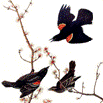Wildlife Damage Management, Internet Center for
Document Type
Article
Date of this Version
October 1973
Abstract
Red-winged Blackbirds (Agelaius phoeniceus) are one of the primary species of birds contributing to agricultural damage throughout the United States. Methods have been developed for reducing the damage they cause to ripening corn (De Grazio et al. 1971; 1972), sprouting corn (Stickley and Guarino, 1972), ripening rice (DeHaven et al. 1971), and windrowed peanuts (Mott et al. 1972). These methods frighten or repel Redwings from crops; however, in some situations, techniques are also needed to manage specific problem-bird populations by reducing their numbers. At present, the primary methods for reducing large numbers of problem birds involve the use of chemical toxicants and wetting agents. These methods are often only temporary and, in this age of environmental awareness, generally are not accepted by the public. The proper use of avian chemosterilants for population reduction should be safer, more specific, and more acceptable; it could, in fact, be more effective. For example, Knipling (1959) showed mathematically that it was more efficient to control insect populations by sterilizing males than by killing them. Further, in territorial birds, if a sterilized individual continues to occupy and defend its territory, the breeding habitat is made less productive. With these advantages in mind, personnel of the Section of Bird Damage Control at the Denver Wildlife Research Center began to investigate the possibilities of reducing Red-winged Blackbird populations by chemosterilants in 1969.


